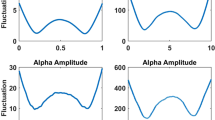Abstract
Temporal stability of a given measurement within individual participants is a desirable property of psychophysiological measures. The present study aims to examine the reliability of high-frequency oscillatory activity in the human electroencephalogram (EEG) across 4 sessions. Convolution of the EEG time series with Morlet wavelets yielded time-frequency representations of the signal for each session. Stability of both topography and time course of gamma-band activity (GBA) was determined for two participants performing a feature-based selective attention task in four separate sessions, spaced at weekly intervals. We found high temporal stability of non-phase-locked GBA typically occurring in time ranges between 200 and 500 ms following presentation of a stimulus, both in terms of topography and time course. Early phase-locked GBA (80-120 ms) showed higher variability with respect to topography, but was consistent in terms of time course. We conclude that measures of high-frequency oscillatory activity as used in the cognitive neurosciences meet stability requirements necessary for meaningful interpretation of this parameter of brain function.
Similar content being viewed by others
References
Basar, E., Basar-Eroglu, C., Karakas, S. and Schürmann, M. Gamma, alpha, delta, and theta oscillations govern cognitive processes. Int. J. Psychophysiol., 2001, 39: 241-248.
Bertrand, O., Bohorquez, J. and Pernier, J. Time-frequency digital filtering based on an invertible wavelet transform: an application to evoked potentials. IEEE Trans. Biomed. Eng., 1994, 41: 77-88.
Desimone, R. Neural mechanisms for visual memory and their role in attention. Proc. Natl. Acad. Sci. USA, 1996, 93: 13494-13499.
Dumenko, V.N. Dynamic shifts in the parameters of the traditional frequency range of the EEG during learning in dogs. Neurosci. Behav. Physiol., 1995, 25: 403-412.
Freeman, W.J. Role of chaotic dynamics in neural plasticity. Prog. Brain Res., 1994, 102: 319-333.
Gruber, T., Muller, M.M. and Keil, A. Modulation of induced gamma band responses in a perceptual learning task in the human EEG. J. Cogn. Neurosci., 2002, 14: 732-744.
Gruber, T., Müller, M.M., Keil, A. and Elbert, T. Selective visual-spatial attention alters induced gamma band responses in the human EEG. Clin. Neurophysiol., 1999, 110: 2074-2085.
Hauk, O., Keil, A., Elbert, T. and Müller, M.M. Comparison of data transformation procedures to enhance topographical accuracy in time series analysis of the human EEG. J. Neurosci. Methods, 2002, 113: 111-122.
Herrmann, C.S., Mecklinger, A. and Pfeifer, E. Gamma responses and ERPs in a visual classification task. Clin. Neurophysiol., 1999, 110: 636-642.
Juergens, E., Guettler, A. and Eckhorn, R. Visual stimulation elicits locked and induced gamma oscillations in monkey intracortical-and EEG-potentials, but not in human EEG. Exp. Brain Res., 1999, 129: 247-259.
Junghöfer, M., Elbert, T., Tucker, D.M. and Rockstroh, B. Statistical control of artifacts in dense array EEG/MEG studies. Psychophysiology, 2000, 37: 523-532.
Keil, A. The role of human prefrontal cortex in motivated perception and behavior: A macroscopic perspective. In: S. Otani (Ed.), Prefrontal Cortex: From Synaptic Plasticity to Cognition. Kluwer, New York, in press.
Keil, A., Gruber, T. and Müller, M.M. Functional correlates of macroscopic high-frequency brain activity in the human visual system. Neurosci. Biobehav. Rev., 2001a, 25: 527-534.
Keil, A., Müller, M.M., Gruber, T., Stolarova, M., Wienbruch, C. and Elbert, T. Effects of emotional arousal in the cerebral hemispheres: a study of oscillatory brain activity and event-related potentials. Clin. Neurophysiol., 2001b, 112: 2057-2068.
Keil, A., Müller, M.M., Gruber, T., Wienbruch, C. and Elbert, T. Human large-scale oscillatory brain activity during an operant shaping procedure. Brain Res. Cogn. Brain Res., 2001c, 12: 397-407.
Keil, A., Müller, M.M., Ray, W.J., Gruber, T. and Elbert, T. Human gamma band activity and perception of a gestalt. J. Neurosci., 1999, 19: 7152-7161.
Müller, M.M., Gruber, T. and Keil, A. Modulation of induced gamma band activity in the human EEG by attention and visual information processing. Int. J. Psychophysiol., 2000, 38: 283-299.
Sannita, W.G. Stimulus-specific oscillatory responses of the brain: a time/frequency-related coding process. Clin. Neurophysiol., 2000, 111: 565-583.
Sinkkonen, J., Tiitinen, H. and Naatanen, R. Gabor filters: an informative way for analysing event-related brain activity. J. Neurosci. Methods, 1995, 56: 99-104.
Slobounov, S., Tutwiler, R., Slobounova, E., Rearick, M. and Ray, W. Human oscillatory brain activity within gamma band (30-50 Hz) induced by visual recognition of non-stable postures. Brain Res. Cogn. Brain Res., 2000, 9: 177-192.
Tallon-Baudry, C. and Bertrand, O. Oscillatory gamma activity in humans and its role in object representation. Trends Cogn. Sci., 1999, 3: 151-162.
Tallon-Baudry, C., Bertrand, O., Delpuech, C. and Pernier, J. Oscillatory gamma-band (30-70 Hz) activity induced by a visual search task in humans. J. Neurosci., 1997, 17: 722-734.
Yordanova, J., Banaschewski, T., Kolev, V., Woerner, W. and Rothenberger, A. Abnormal early stages of task stimulus processing in children with attention-deficit hyperactivity disorder-evidence from event-related gamma oscillations. Clin. Neurophysiol., 2001, 112: 1096-1108.
Author information
Authors and Affiliations
Rights and permissions
About this article
Cite this article
Keil, A., Stolarova, M., Heim, S. et al. Temporal Stability of High-Frequency Brain Oscillations in the Human EEG. Brain Topogr 16, 101–110 (2003). https://doi.org/10.1023/B:BRAT.0000006334.15919.2c
Issue Date:
DOI: https://doi.org/10.1023/B:BRAT.0000006334.15919.2c




